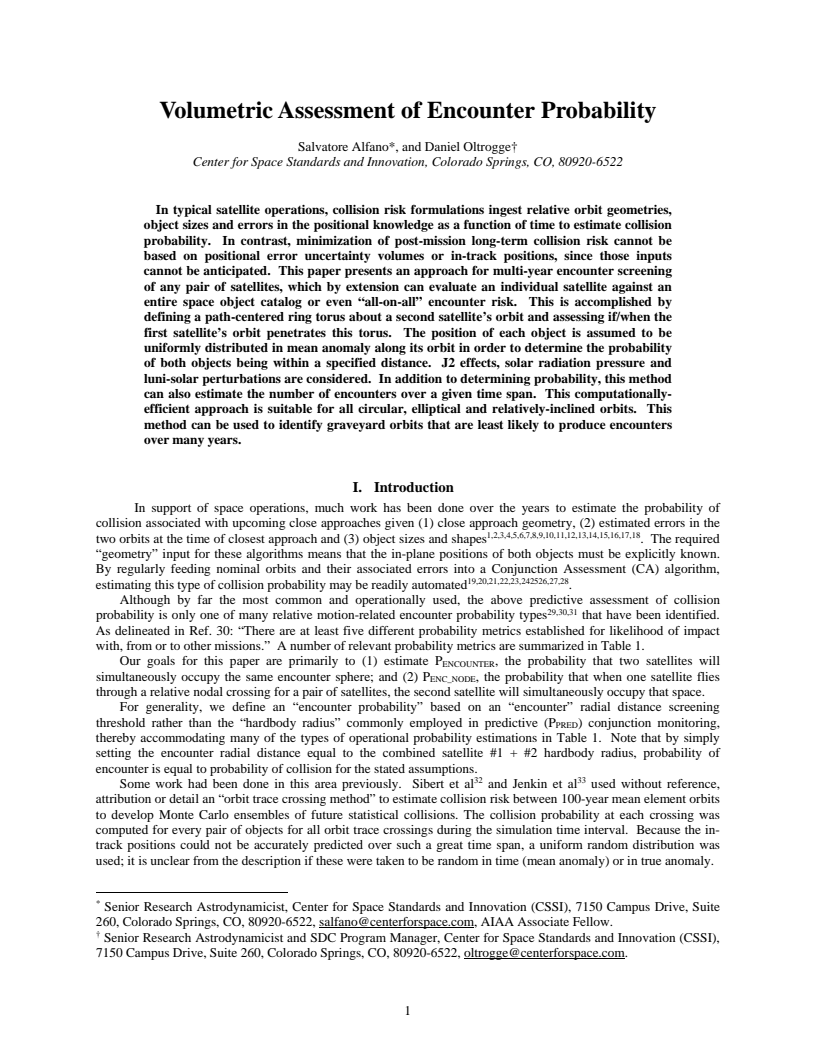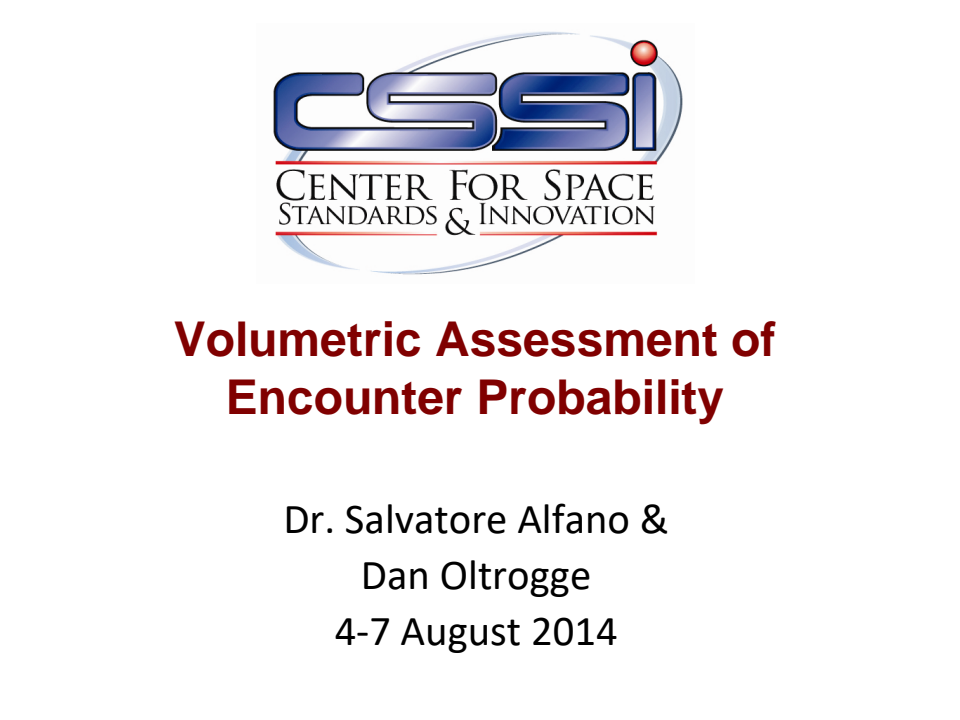Volumetric Assessment of Encounter Probability


Id: 259
Type: Conference paper
Published: 08/08/2014
Event: AIAA/AAS Astrodynamics Specialist Conference 2014
Authors:
Click an author to filter the list of related assets below.Abstract:
In typical satellite operations, collision risk formulations ingest relative orbit geometries, object sizes and errors in the positional knowledge as a function of time to estimate collision probability. In contrast, minimization of post-mission long-term collision risk cannot be based on positional error uncertainty volumes or in-track positions, since those inputs cannot be anticipated. This paper presents an approach for multi-year encounter screening of any pair of satellites, which by extension can evaluate an individual satellite against an entire space object catalog or even “all-on-all” encounter risk. This is accomplished by defining a path-centered ring torus about a second satellite’s orbit and assessing if/when the first satellite’s orbit penetrates this torus. The position of each object is assumed to be uniformly distributed in mean anomaly along its orbit in order to determine the probability of both objects being within a specified distance. J2 effects, solar radiation pressure and luni-solar perturbations are considered. In addition to determining probability, this method can also estimate the number of encounters over a given time span. This computationally-efficient approach is suitable for all circular, elliptical and relatively-inclined orbits. This method can be used to identify graveyard orbits that are least likely to produce encounters over many years.
Keywords:
Click a keyword to filter the list of related assets below.Citation:
Alfano, S. and Oltrogge, D.L., “Volumetric Assessment of Encounter Probability,” AIAA/AAS Astrodynamics Specialist Conference, San Diego, CA 8 August 2014, accessible at https://comspoc.com/Resources/Content/Private/C-20220424T074248/Paper/Volumetric%20Assessment%20of%20Satellite%20Encounters%20DOC_v40.pdf.
Papers with related authors:

Using Spacebook and Cesium to Promote and Enhance Flight Safety
Read More
Actionability and Persistence Of Conjunction Data
Read More
Actionability and Persistence of Conjunction Data
Read More
Synthetic Covariance Production Using a New Digital Approach
Read More
Actionability and Persistence of Conjunction Data
Read More


Comparison of predicted and observed spacecraft encounters from Russian ASAT test
Read More
Efficient assessment of long-term encounter rates with CSSI’s volumetric encounter method
Read More
Russian ASAT Debris Cloud Evolution and Risk
Read More
Evaluation of LEO conjunction rates using historical flight safety systems and analytical algorithms
Read More
Innovative LCOLA tool prioritizing accuracy, launch access and efficiency
Read More
SSA positional and dimensional accuracy requirements for Space Traffic Coordination and Management
Read More
Risk Assessment of Recent High-Interest Conjunctions
Read More
Results of comprehensive STCM data fusion experiment
Read More
Risk Assessment of Recent High-Interest Conjunctions
Read More
LEO constellation encounter and collision rate estimation: an update
Read More
The cost of not doing debris remediation
Read More
The technical challenges of better Space Situational Awareness and Space Traffic Management
Read More
Probability of Collision: Valuation, variability, visualization, and validity
Read More

A comprehensive assessment of collision likelihood in Geosynchronous Earth Orbit
Read More

Probability of Collision: Valuation, Variability, Visualization, and Validity
Read More

Addressing the debilitating effects of maneuvers on SSA accuracy and timeliness
Read More


Updated Analytical Partials for Covariance Transformations and Optimization
Read MorePapers with related keywords:

Efficient assessment of long-term encounter rates with CSSI’s volumetric encounter method
Read More
Volumetric assessment of satellite encounter rates
Read More

Volumetric encounter analysis enhancements
Read More
Space Traffic Coordination Framework for Success
Read MoreVideos with related keywords:
Depiction of how encounter rates and collision risk varies as a function of accuracy of the underlying SSA data.
Watch VideoEvolution in rate of LEO close approaches with major fragmentation events, 1968 to present (viewed slightly from lefthand side)
Watch VideoEvolution in rate of LEO close approaches with major fragmentation events, 1968 to present (viewed slightly from righthand side)
Watch Video